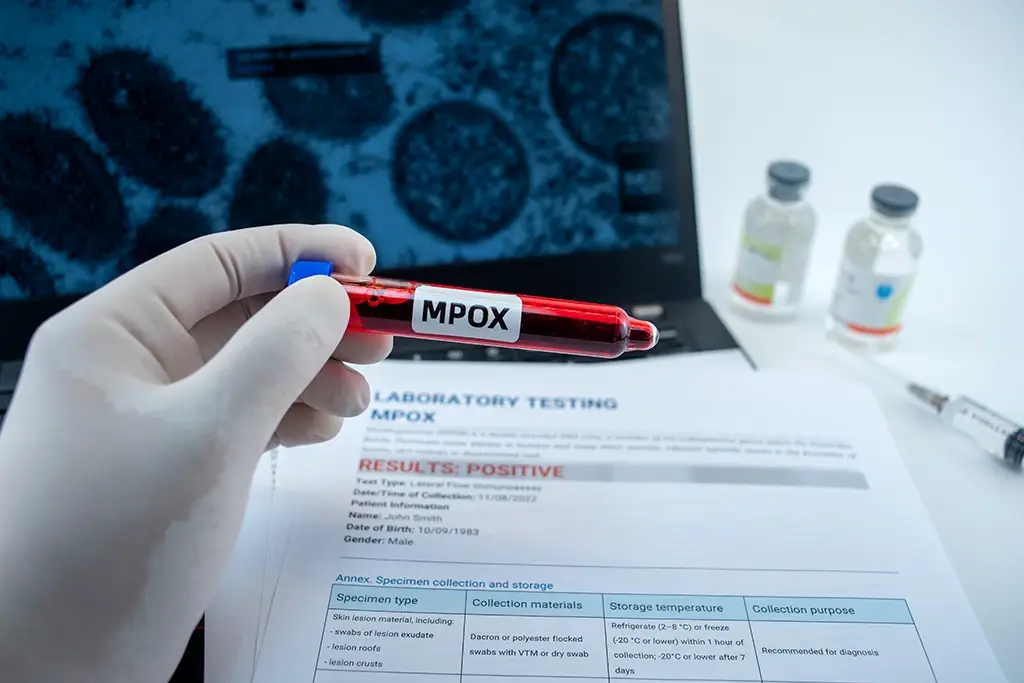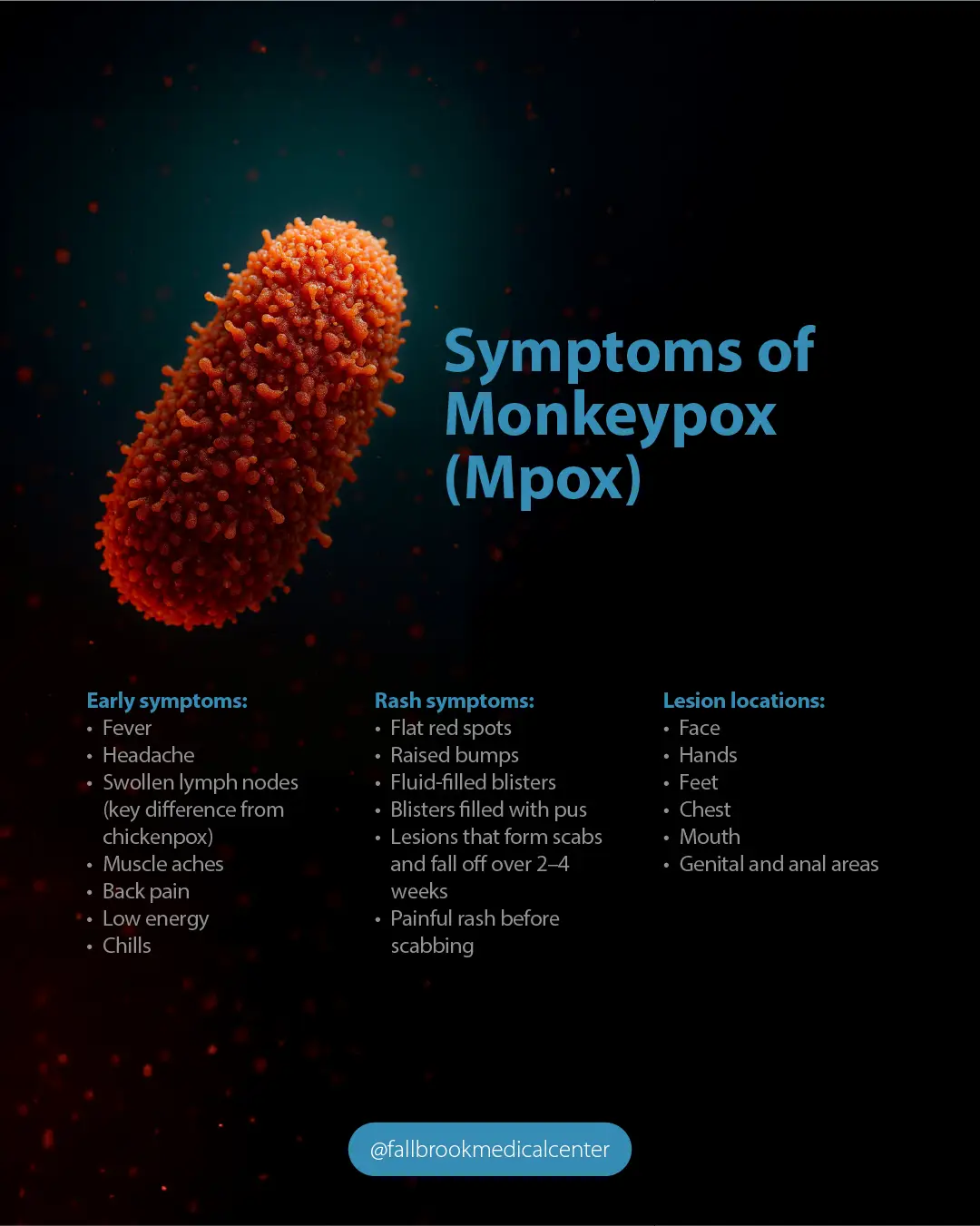(Mpox) Monkeypox in California: Symptoms, Spread & Prevention

Mpox, formerly known as monkeypox, is a viral disease. The monkeypox virus, a relative of the smallpox virus, causes this illness. It typically produces flu-like symptoms and a characteristic skin rash.
Researchers first identified mpox in the Democratic Republic of the Congo in 1970. For decades, the virus primarily affected parts of Central and West Africa who.int.
However, in 2022 a global outbreak of clade II mpox spread to over 100 countries, including the United States cdc.gov. The outbreak heavily affected California. It saw thousands of cases and prompted public health measures.
This article provides an updated overview of monkeypox/mpox and its symptoms. It also explains how mpox spreads through human-to-human transmission. The article outlines ways to prevent mpox and describes the current situation in California.
We attend to minor medical emergencies
Symptoms of Monkeypox (Mpox)
People with mpox often experience a combination of general illness and skin problems. Early symptoms can include fever, headache, swollen lymph nodes, muscle aches, back pain, low energy, and chills.
Within a few days, a dmpoxistinctive rash typically develops. The rash starts as flat red spots that progress to raised bumps, then to fluid-filled blisters, which eventually fill with pus. Over 2–4 weeks, these lesions crust over into scabs and fall off as they heal.
People with mpox often develop sores that vary in number. These lesions usually appear on the face, hands, feet, chest, mouth, or genital area. In the 2022 outbreak, many cases showed lesions in the genital and anal regions. The rash can be quite painful until it scabs, and some patients also suffer sore throat, cough, or swollen lymph nodes.
Most mpox cases in the recent outbreak have been mild, and patients recover in a few weeks without specific therapy. Many people confuse monkeypox with chickenpox. Despite the similar names, these are entirely different diseases.
A key difference from chickenpox is that mpox causes notable lymph node swelling. Mpox can cause serious complications in some cases. This risk increases for young children, pregnant individuals, and people with weakened immune systems.
By contrast, the older Central African strain (clade I) remains endemic in parts of Africa. Historically, this strain showed a higher mortality rate of about 3–10%, especially in impoverished settings universityofcalifornia.edu. Thanks to better health care, even the more severe clade I infections have shown lower death rates in recent outbreaks.

How Monkeypox Spreads (Transmission)
Monkeypox does not spread as easily as COVID-19 or the flu. However, it can transmit through close contact with infected individuals or animals. Human-to-human transmission of mpox primarily requires direct physical contact or exchange of bodily fluids.
The highest risk comes from close contact with the rash, sores, or scabs of someone who is infected. Transmission includes skin-to-skin contact, such as touching or kissing the lesions. It can also occur through prolonged face-to-face contact, which allows the exchange of respiratory droplets.
During the 2022 global outbreak, many cases were linked to intimate or sexual contact. Experts have identified activities like oral, anal, or vaginal sex as major routes of transmission. People spread the virus through intimate behaviors such as hugging, massaging, or kissing. These actions contributed to transmission within social networks where the virus was active.
It’s important to clarify that mpox is not strictly a sexually transmitted infection. Anyone can get infected through close physical contact. However, the virus has spread more rapidly in close-contact networks within certain communities.
Besides direct contact, monkeypox can also spread by touching objects or surfaces contaminated with the virus. For example, sharing bedding, towels, or clothing used by an infected person could potentially transmit the virus. This type of transmission requires a high viral load. Although the virus does not survive long on surfaces, researchers have documented some cases of this form of spread.
Monkeypox is not an airborne virus in the typical sense; you are unlikely to catch it from simply being in the same room. Mpox can transmit through large respiratory droplets. This happens during long face-to-face contact with someone who has mouth or throat lesions.
Monkeypox can also pass from animals to humans (it is a zoonotic virus). In Africa, people have become infected after bites or scratches from rodents and other wildlife carrying the virus. Others have been infected by handling or preparing meat from infected animals.
In 2022, the U.S. outbreak resulted entirely from human-to-human transmission. No animals were involved domestically. In 2003, people got infected after handling prairie dogs exposed to imported African rodents.
A person with mpox becomes contagious once symptoms start, especially if a rash is present. They remain infectious until all lesions have scabbed over, fallen off, and new skin has formed. Close contact with an infected person during this period can lead to transmission.
Prevention and Mpox Vaccines
Preventing mpox relies on reducing contact with the virus and using vaccines for those at risk. Follow standard hygiene measures to reduce risk. Avoid direct contact with rashes or body fluids from an infected person. Do not share bedding or personal items with them, and practice good handwashing.
If you are caring for someone with mpox, use protective gloves and a mask, and keep lesions covered if possible. Avoid close contact, including sexual activity, with anyone who has a new or unexplained rash. Wait for a medical evaluation. It’s also advisable to communicate openly with intimate partners about any recent illness or skin changes.
In terms of community health measures, education and awareness are key. Public health officials have emphasized outreach in communities that experienced higher transmission, encouraging behavior changes during outbreak peaks. For example, limiting your number of intimate partners during an active outbreak wave can reduce risk. Disinfecting surfaces and laundering clothes or sheets that an infected person used are additional precautions to prevent indirect spread.
Monkeypox in California: The Current Outlook
California experienced a significant mpox outbreak starting in mid-2022, as the virus spread in communities across the state. By late summer 2022, California had more confirmed mpox cases than any other U.S. state. Officials reported over 4,000 cases. Later, the number rose past 5,000 cases statewide.
Cities like Los Angeles and San Francisco set up mass vaccination clinics for the most affected groups. Thanks to these efforts and changes in behavior within communities at risk, the outbreak slowed down. By the end of 2022, new infections had dropped dramatically from their peak.
Throughout 2023, only a low level of mpox transmission persisted in California. For much of that year, the state saw only a handful of cases per week on average cdph.ca.gov. The low baseline likely resulted from prior immunity, vaccination, and strong public health efforts.
However, health officials have cautioned that mpox has not disappeared. In fact, toward the fall of 2023, surveillance noted a slight uptick in cases. California went from roughly 1–7 case of mpox per week in mid-2023 to around 17 cases per week by late September 2023 cdph.ca.gov.
Viral DNA in wastewater showed the mpox virus still circulated at low levels across parts of the state cdph.ca.gov. Most cases occurred in MSM networks, including many with at least one vaccine dose. The rise showed that vaccines work, but breakthrough infections occur, so ongoing caution remains essential.
In a noteworthy development, California reported the first U.S. case of clade I mpox in late 2024 cdc.gov. In November 2024, a California traveler was diagnosed with the Central African strain after visiting Eastern Africa cdc.gov. This was the first time the more virulent clade I had been identified in the United States. The patient was isolated and recovered, and fortunately this did not lead to any further spread.
Health officials confirmed that the case was linked to an ongoing outbreak in Africa and was an isolated event. The CDC stressed that risk to Americans remained low, with few travel-related clade I cases ever reported in the U.S cdc.gov. Most confirmed cases in the U.S. and California remain from the less severe clade II lineage.
Though no longer in headlines, monkeypox persists at low levels, and awareness helps reduce the risk of infection. The mpox outbreak taught California and the world a key lesson in infectious disease preparedness. It showed the power of targeted health care interventions. It also highlighted the role of community cooperation in stopping an emerging virus.
We attend to minor medical emergencies
Sources
- World Health Organization. (2023, August). Mpox (Fact Sheet).
- Centers for Disease Control and Prevention. (2024, August 22). FACT SHEET: United States Response to the Clade I Mpox Outbreak in Several African Countries.
- Cleveland Clinic. (2023, updated). Mpox (Monkeypox): Causes, Symptoms, Treatment & Prevention.
- Fernandes, L. (2024, August 22). Here’s what to know about the mpox outbreak emergency. University of California News.
- Centers for Disease Control and Prevention. (2024, November 16). California confirms first clade I mpox case
- California Department of Public Health. (2023, October 30). Increase in Mpox Cases in California – Updates on Identification, Testing, Treatment, and Vaccination

